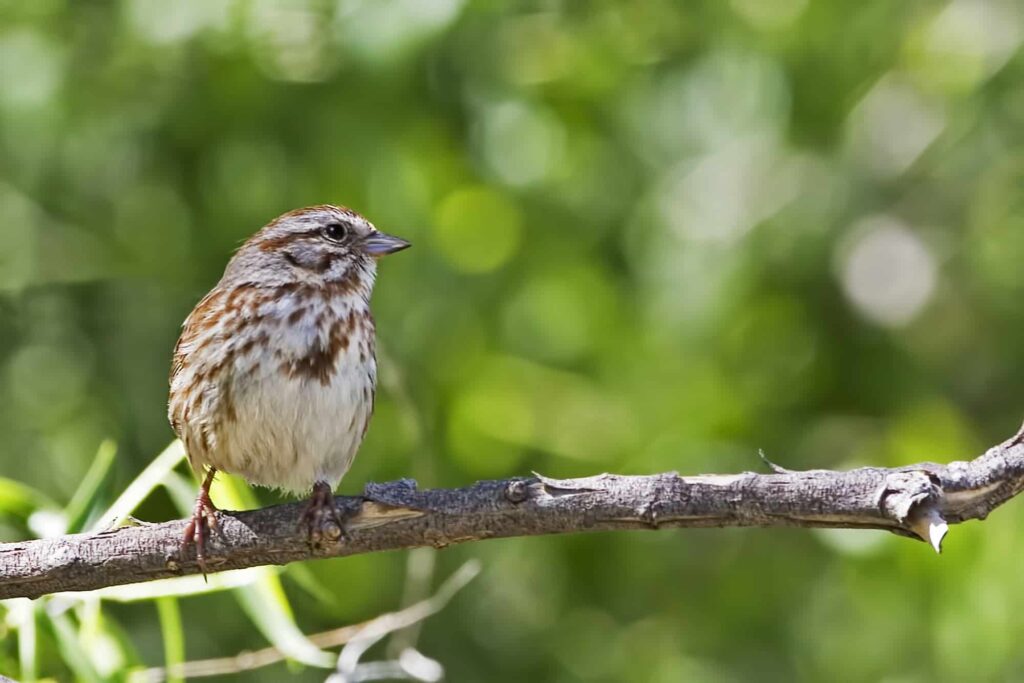With its hot, humid summers and mild winter climate, Georgia is a prized destination for many bird species and bird watchers alike! Vast swamps in the south of the state, the Appalachian mountains in the north, as well as dense woodlands and the Atlantic coastline give Georgia a diverse landscape with an array of habitat niches for 425 species of birds.
22 of these are sparrows, and today I’m going to be guiding you through all of the sparrow species in Georgia, starting with the most common resident and ending with the rarest example.
Sparrows are endearing birds and many species are fairly tame and easy to coax into your backyard by offering them a bird feeder or a bird bath. Others prefer life out in the wild and require a dedicated effort and a good pair of binoculars to spot and identify them.
Here I’ll be sharing some fascinating facts about the sparrows of Georgia, and I’ll also be offering some top tips on how to identify different members of this tricky tribe of birds!
Let’s get started!
22 Species of Sparrow in Georgia, Starting With the Most Common
Eastern Towhee

- Scientific Name: Pipilo erythrophthalmus
- Length: 6.8-8.2 in (17.3-20.8 cm)
- Weight: 1.1-1.8 oz (32-52 g)
- Wingspan: 7.9-11.0 in (20-28 cm)
Large, chunky, and colorful, the eastern towhee is not only the most common but perhaps the most visually distinctive of all sparrows in Georgia, too. Their striking jet-black upper body, white chest, rusty red flanks, and long tail make this bird easy to identify.
Although you may not think of towhees as sparrows, they are as much a part of the New World Sparrow family as any other bird on our list. Although they’re visually very similar to spotted towhees in the west, eastern towhees inhabit a more eastern geographical range.
These large sparrows are fairly secretive, and largely solitary birds. Look out for them scratching about in the undergrowth in search of various insects and seeds as large as acorns!
Eastern towhees can be seen frequently throughout Georgia year-round, but are slightly less common here in summer when some of the population heads north for breeding.
Chipping Sparrow
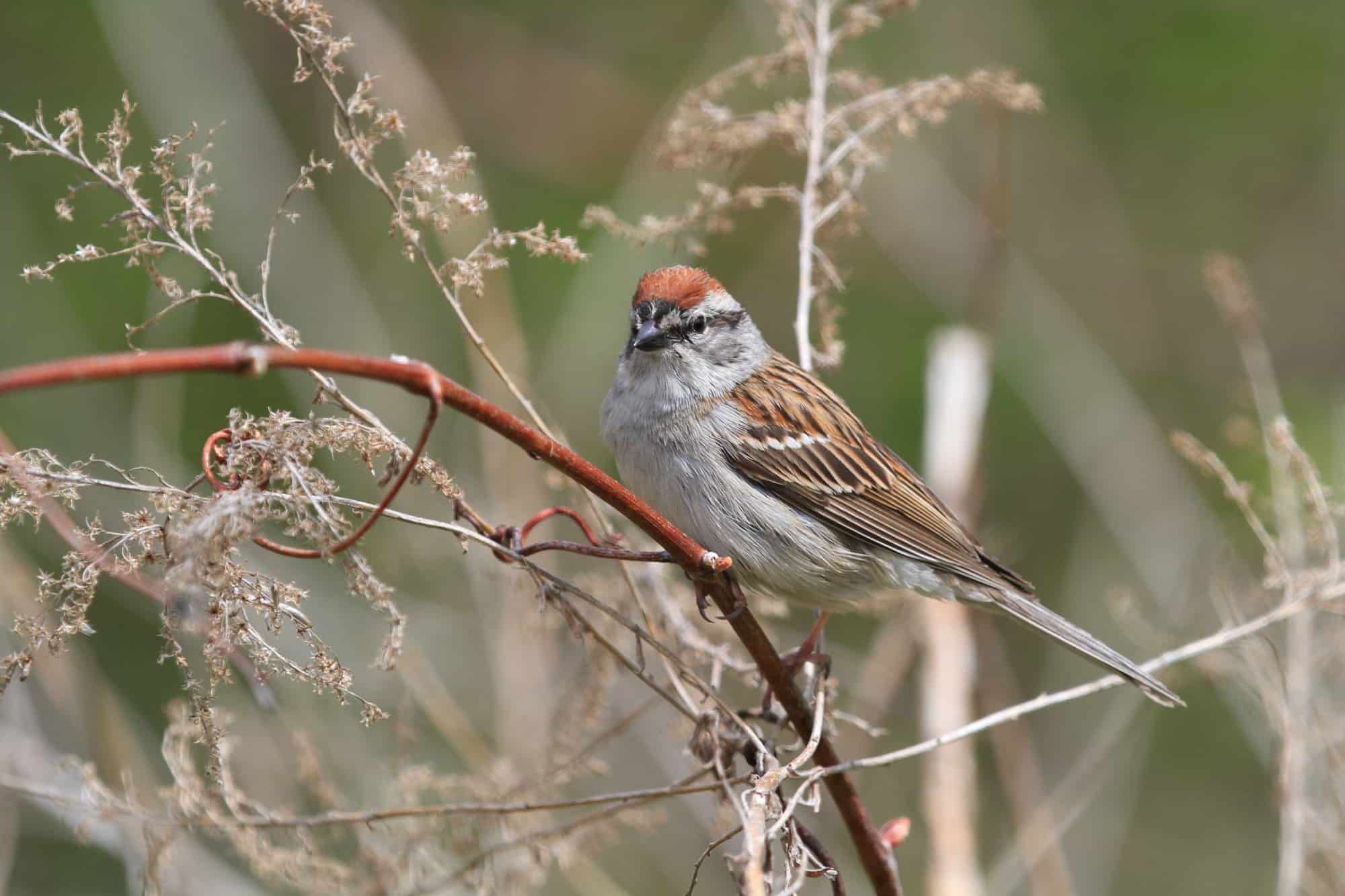
- Scientific Name: Spizella passerina
- Length: 4.7-5.9 in (12-15 cm)
- Weight: 0.4-0.6 oz (11-16 g)
- Wingspan: 8.3 in (21 cm)
Chipping sparrows are named after their noisy ‘chipping’ and trilling – indeed they are one of the most vocal sparrows in North America. They’re also fairly easy to identify by the rusty red streak on their head, gray underside, and black eye lines.
These medium-sized sparrows are a common sight in Georgia, and their numbers remain fairly stable throughout the year. They can be attracted to your backyard bird feeder during winter by offering them sunflower seeds, cracked corn, and other similar seeds.
Chipping sparrows build their nests out of dried grass and roots and can raise three broods in a single season!
Song Sparrow

- Scientific Name: Spizelloides arborea
- Length: 5.5 in (14 cm)
- Weight: 0.5-1.0 oz (13-28 g)
- Wingspan: 9.4 in (24 cm)
Song sparrows are one of the few birds that are more vocal even than the chipping sparrow. Their noisy song throughout the spring and summer can create an almost constant backdrop to life outdoors.
These largish sparrows are one of the most common sparrows in Georgia during the winter, but plenty of them stick around for breeding here, too.
As opportunistic feeders, song sparrows will eat a vast variety of food items, including insects and worms, various grains, and even berries and small fruits.
You can attract them to your backyard with a feeder, or by planting trees and shrubs such as wild cherries that produce fruit for them to eat.
White-throated Sparrow
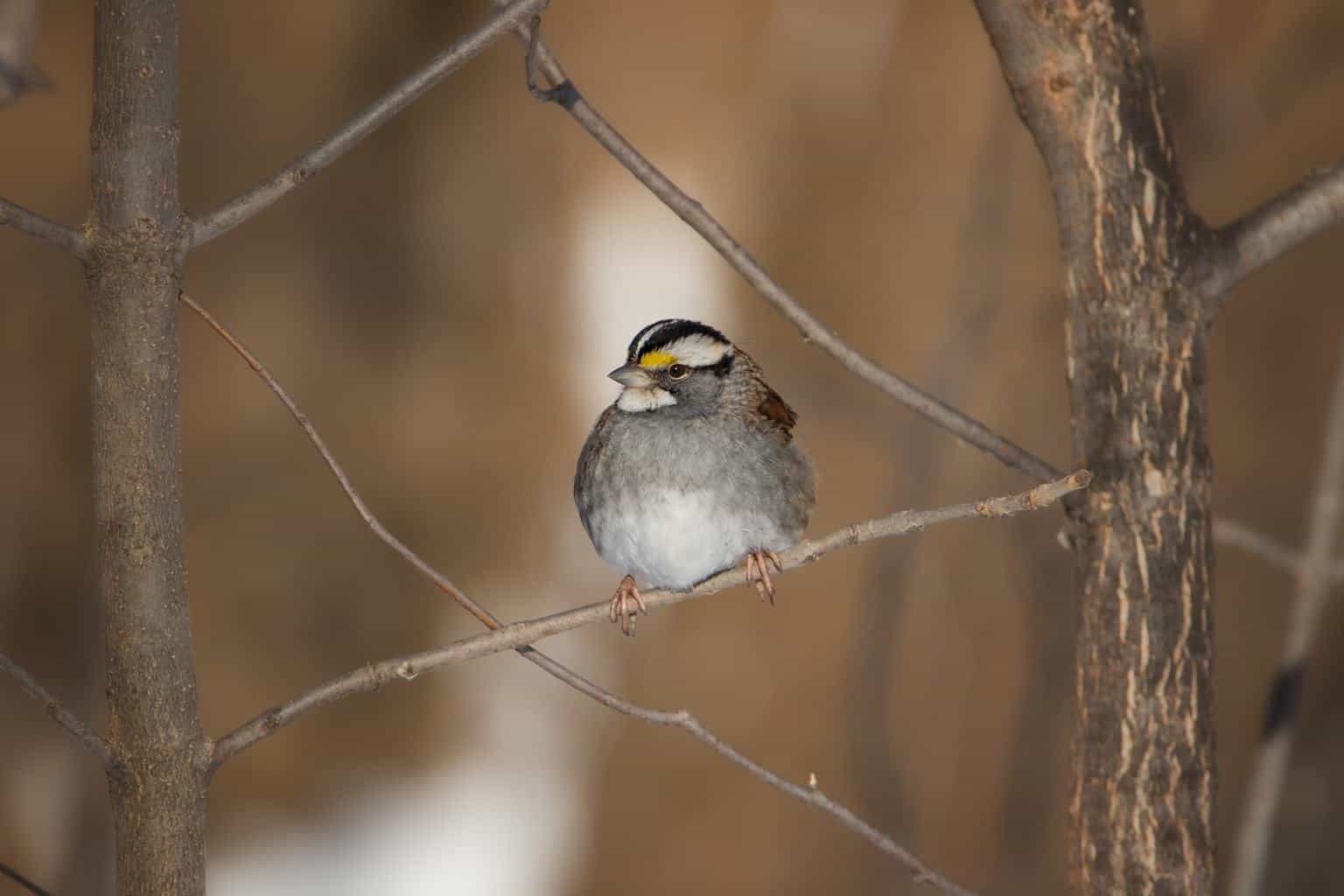
- Scientific Name: Zonotrichia albicollis
- Length: 6.3-7.1 in (16-18 cm)
- Weight: 0.8-1.1 oz (22-32 g)
- Wingspan: 7.9-9.1 in (20-23 cm)
The white-throated sparrow is fairly easy to recognize from their black and white (or sometimes tan) striped head, yellow eyebrows, and white throat.
These medium-sized sparrows are a common sight in Georgia during the winter, but in summer they nest mainly in Canada. The rhythm of their rather melancholic song can be remembered by the mnemonic: “Oh Poor Sam Peabody- Peabody-Peabody” or, more appropriately: “Oh Sweet Canada-Canada-Canada!
In the wild, these birds eat insects, seeds, and berries and are easy to attract to backyard and woodland bird feeders with black oil sunflowers seeds and other rich, oily grains.
Dark-eyed Junco
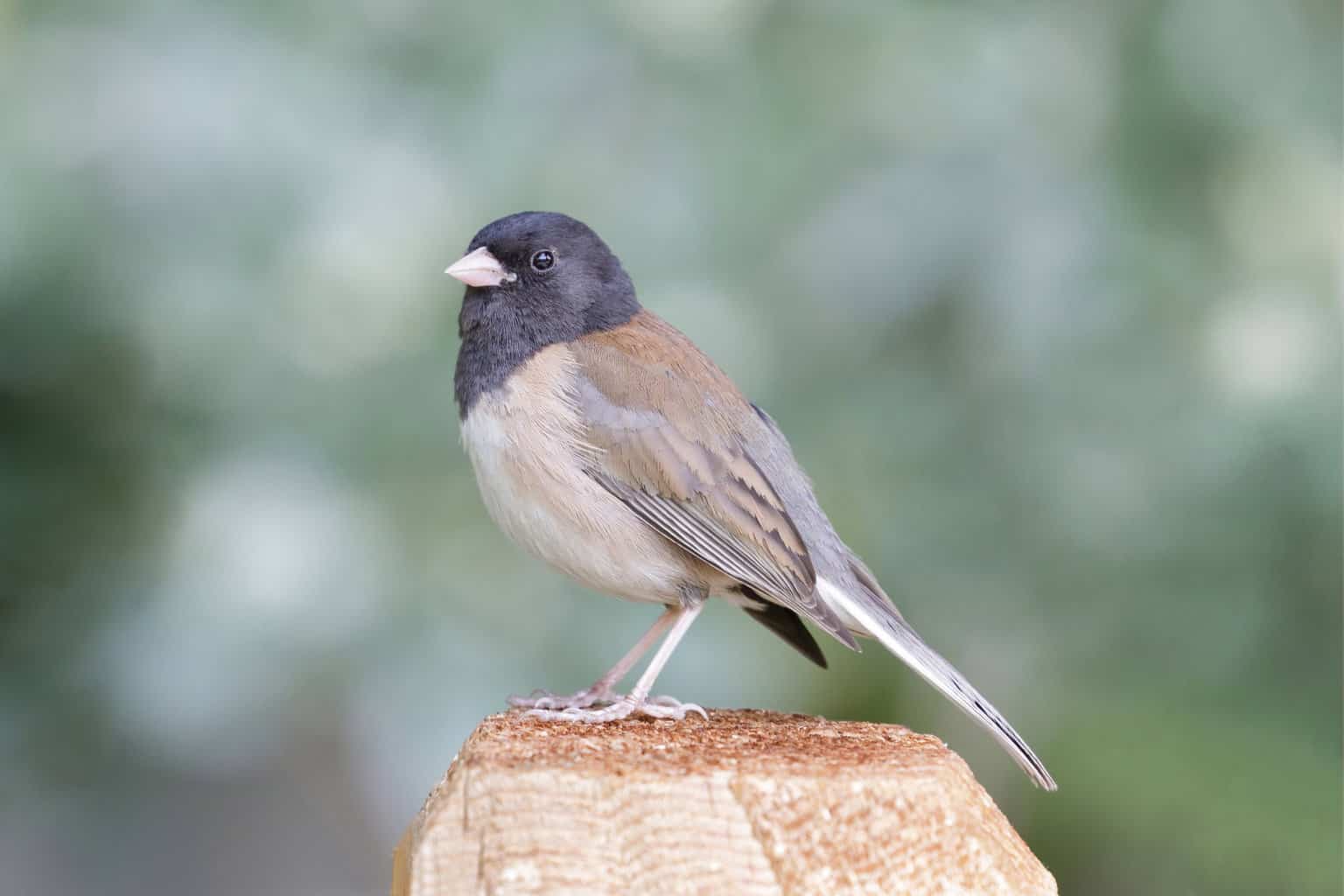
- Scientific Name: Junco hyemalis
- Length: 5.5-6.3 in (14-16 cm)
- Weight: 0.6-1.1 oz (18-30 g)
- Wingspan: 7.1-9.8 in (18-25 cm)
Dark-eyed juncos are fairly large sparrows that have varying plumage depending on which part of America they live in. On the east coast, almost all of them are of the ‘slate-colored’ variety, which perfectly describes the shade of their gray plumage.
Juncos are not always thought of as sparrows, but they are close cousins to the other species here. Georgia is only a wintering ground for this hardy little bird, except for a very small population that nests in the northern mountains.
Dark-eyed juncos are enthusiastic visitors to backyard feeding stations meaning you’re almost certain to see them if you offer them black oil sunflower seeds, millet, and peanuts during the winter.
House Sparrow
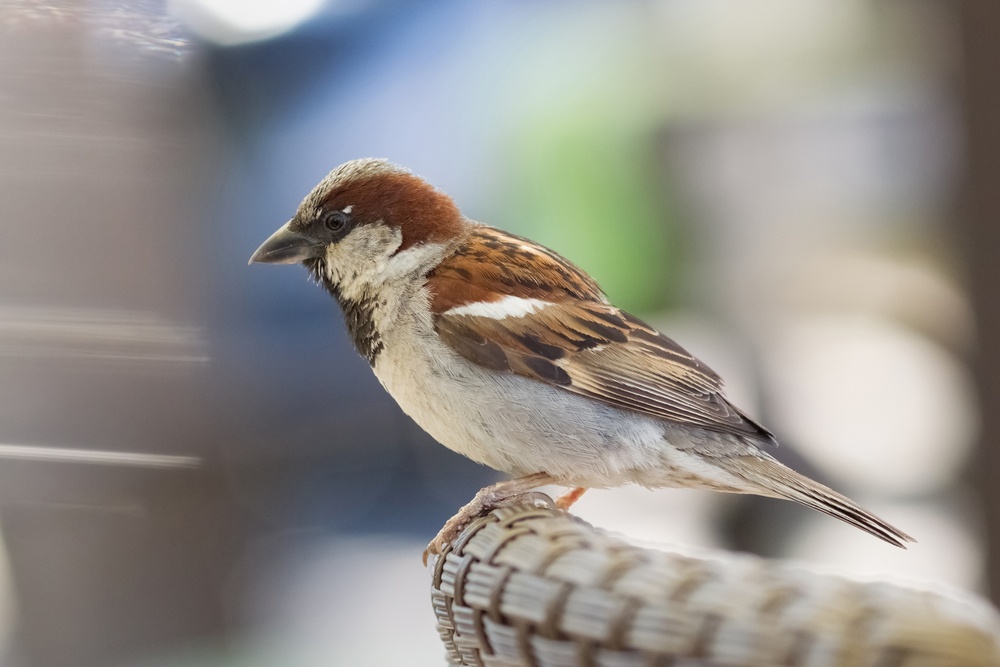
- Scientific Name: Passer domesticus
- Length: 5.9-6.7 in (15-17 cm)
- Weight: 0.9-1.1 oz (27-30 g)
- Wingspan: 7.5-9.8 in (19-25 cm)
House sparrows are not native to the US and were introduced to New York City in 1852 from Europe. They quickly spread and now can be found right across the USA and Southern Canada.
Because they’re not related to native sparrows, house sparrows behave quite differently. They don’t migrate and tend to stick to the same territories throughout the year. Although they’re not as common here as in more northerly states, house sparrows are still a fairly regular sight in Georgia.
Since they sometimes dominate the nesting grounds of native birds, some ornithologists consider house sparrows to be an invasive pest. They are, however, one of the tamest and most endearing sparrows, and can even be trained to eat from your hand!
Field Sparrow
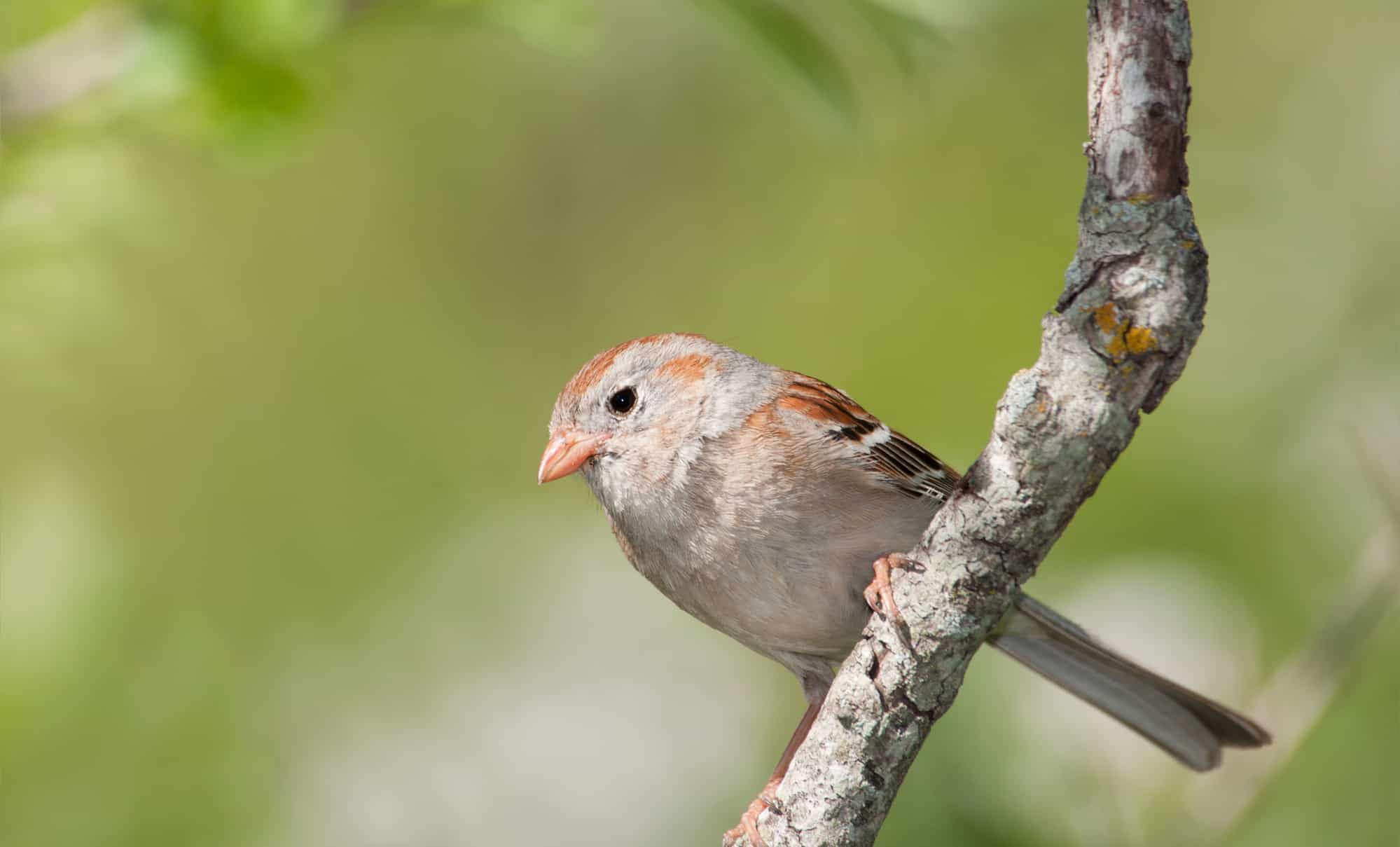
- Scientific Name: Spizella pusilla
- Length: 4.7-5.9 in (12-15 cm)
- Weight: 0.4-0.5 oz (11-15 g)
- Wingspan: 7.9 in (20 cm)
Field sparrows are fairly indistinctive small, brown sparrows. As their name suggests, they prefer life out in the meadows to areas nearby human habitation, and their reclusive nature can make them difficult to spot.
A good way to identify this shy bird is by its high-pitched trill that sounds a bit like a bouncing ball coming to a stop! Males are especially vocal during the breeding season when they’ll often sing from a high perch during the early morning.
Field sparrows have an interesting geographical range that’s almost exclusively within the Central and Eastern United States. These small birds can be seen in Georgia all year, except for the southern part of the coastline where you’ll only see them in winter.
Swamp Sparrow
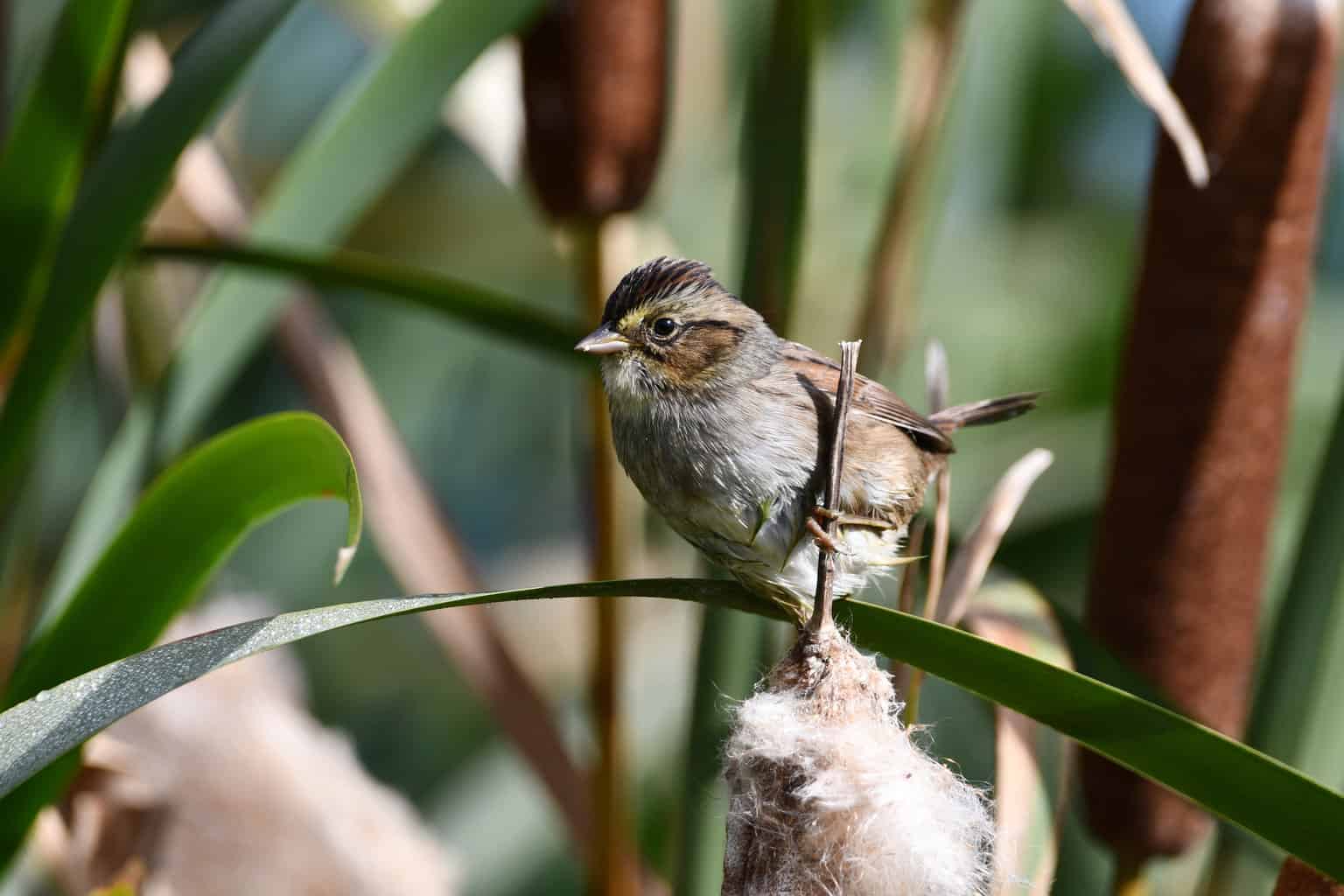
- Scientific Name: Melospiza georgiana
- Length: 4.7-5.9 in (12-15 cm)
- Weight: 0.5-0.8 oz (15-23 g)
- Wingspan: 7.1-7.5 in (18-19 cm)
Swamp sparrows are tiny birds that are most commonly seen around wetlands, coastal marshes, and bogs. As a secretive species, they can be difficult to spot and identify, but a few yellow feathers near their beaks can be seen with a pair of binoculars.
Despite their small size, swamp sparrows have a large migratory range that extends from Central America to Northern Canada. They can occasionally be persuaded to stop off in backyards by offering them a bird bath.
Swamp sparrows are strictly cold-season birds in Georgia, where they begin arriving back in September and October from their northerly breeding grounds. They typically remain here until the following April before making their long flight back north.
Savannah Sparrow
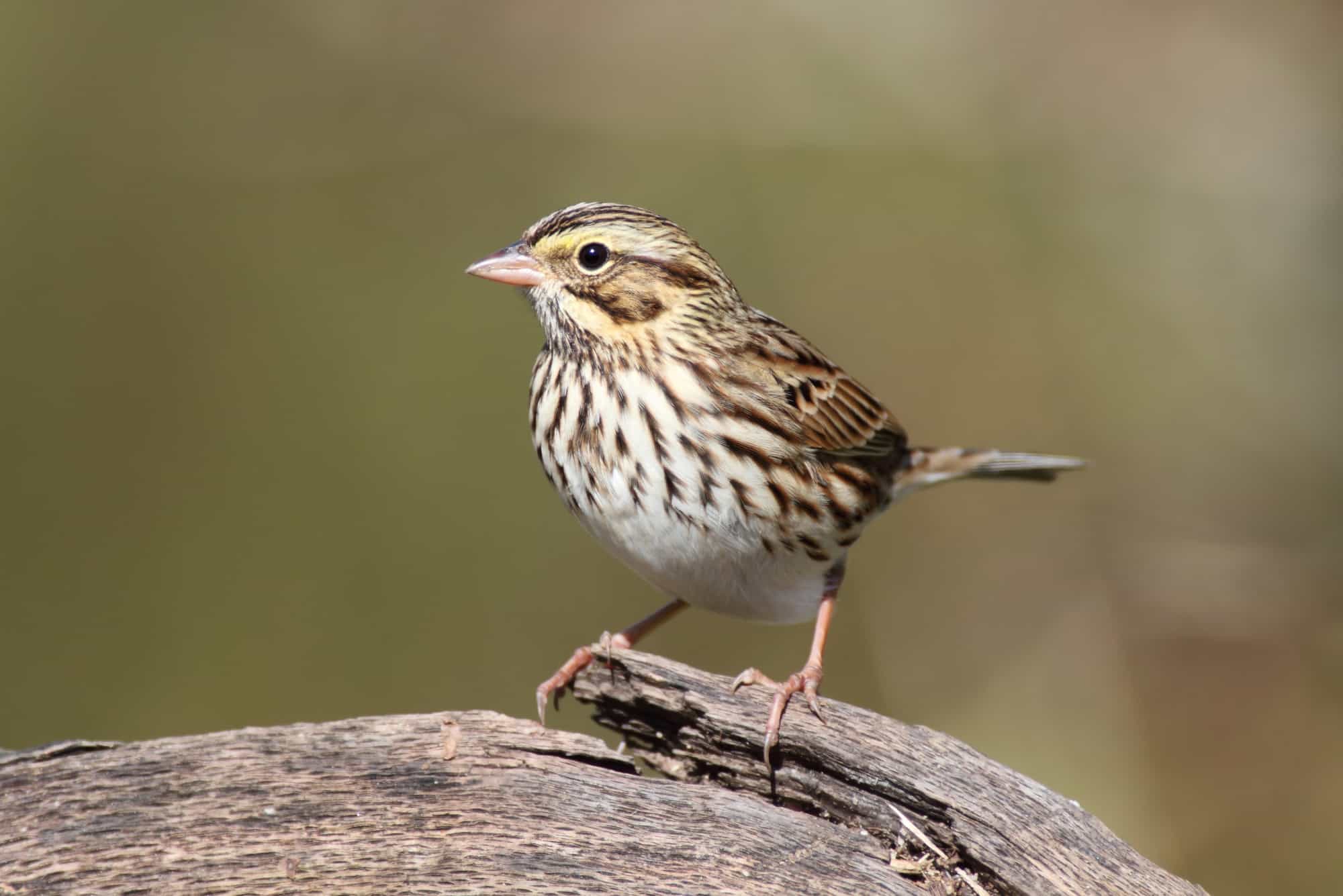
- Scientific Name: Passerculus sandwichensis
- Length: 4.3-5.9 in (11-15 cm)
- Weight: 0.5-1.0 oz (15-28 g)
- Wingspan: 7.9-8.7 in (20-22 cm)
Savannah sparrows are grassland birds that generally prefer to stay away from human habitation. Although they look rather like song sparrows, they can be identified through a pair of binoculars by the yellow wash around their face.
Their song is also a good way to identify them as they prepare for the breeding season – a squeaky whistle, followed by a buzz, and a trill.
These medium-sized sparrows can be seen all across Georgia in the winter, except for the high mountainous region in the north of the state which is also the only part of the state where they breed in the spring and summer. They build their nests on or near the ground out of grass.
Grasshopper Sparrow
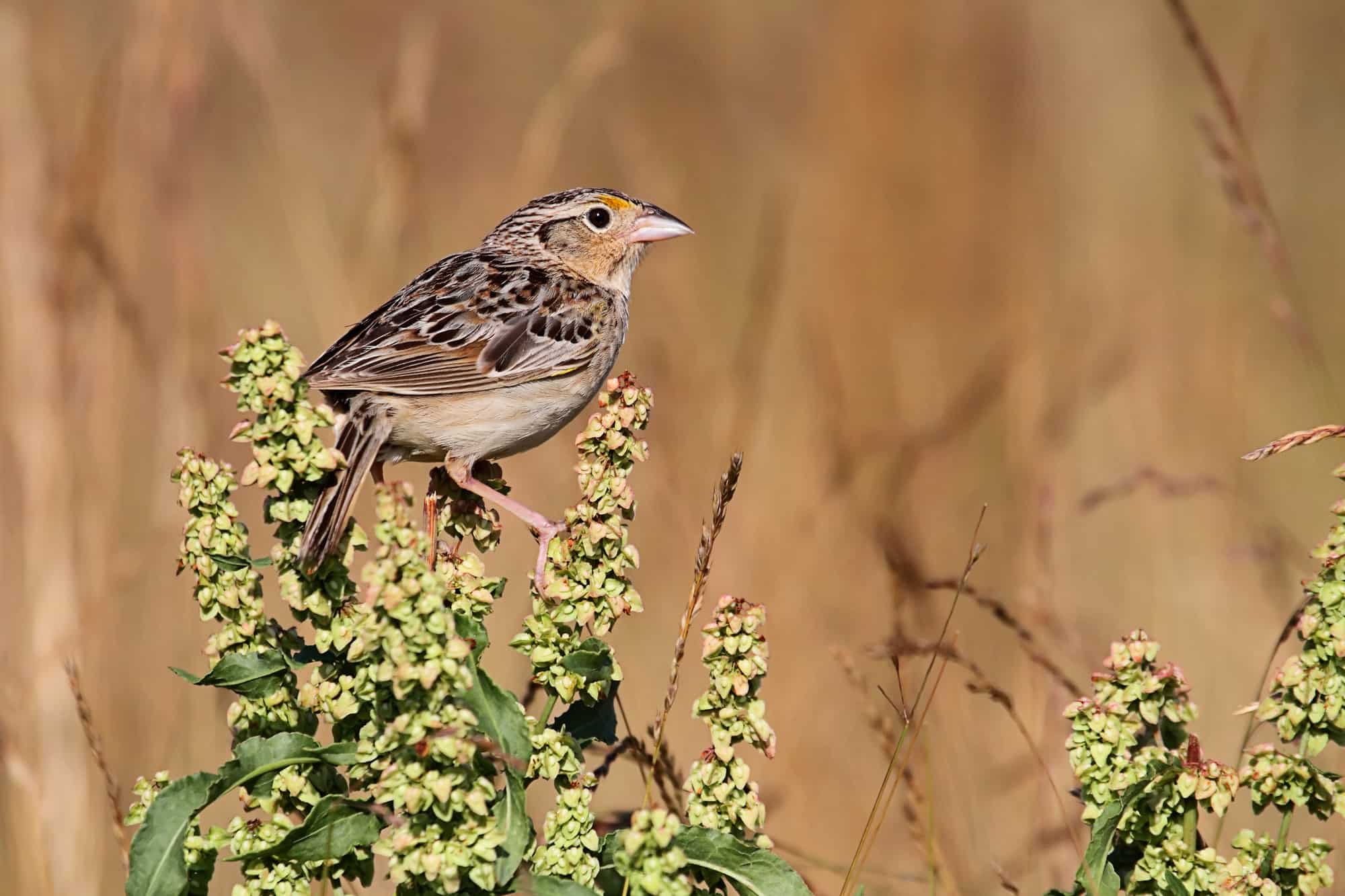
- Scientific Name: Ammodramus savannarum
- Length: 4.3-4.5 in (10.8-11.5 cm)
- Weight: 0.5-0.7 oz (14-20 g)
- Wingspan: 7.9 in (20 cm)
Another tiny bird with an insect-like call, the grasshopper sparrow not only sounds like a grasshopper but also loves preying upon them during the summer when they nest in tall grass.
Although they look rather like the rarer LeConte’s sparrow, they are noticeably larger birds and favor dry grassland habitats over the damp grasslands associated with their cousin.
These secretive sparrows are seen in southern Georgia only during winter, and in the northern mountains only in summer. In the middle of the state, it’s possible to see them year-round, although they are not a frequent sight anywhere in Georgia.
Fox Sparrow

- Scientific Name: Passerella iliaca
- Length: 5.9-7.5 in (15-19 cm)
- Weight: 0.9-1.6 oz (26-44 g)
- Wingspan: 10.5-11.4 in (26.7-29 cm)
Fox sparrows are one of the largest sparrow species and look almost like small thrushes. Their speckled chest and a reddish tint to their brown feathers make them fairly easy to recognize.
These titans of the sparrow family are only present in Georgia during the winter and are never a common sight here. In the spring, they return to their northerly nesting grounds which can extend into the arctic circle!
Fox sparrows can be seen scratching about in the undergrowth looking for insects, seeds, and other tasty morsels, much like thrushes do.
Vesper Sparrow
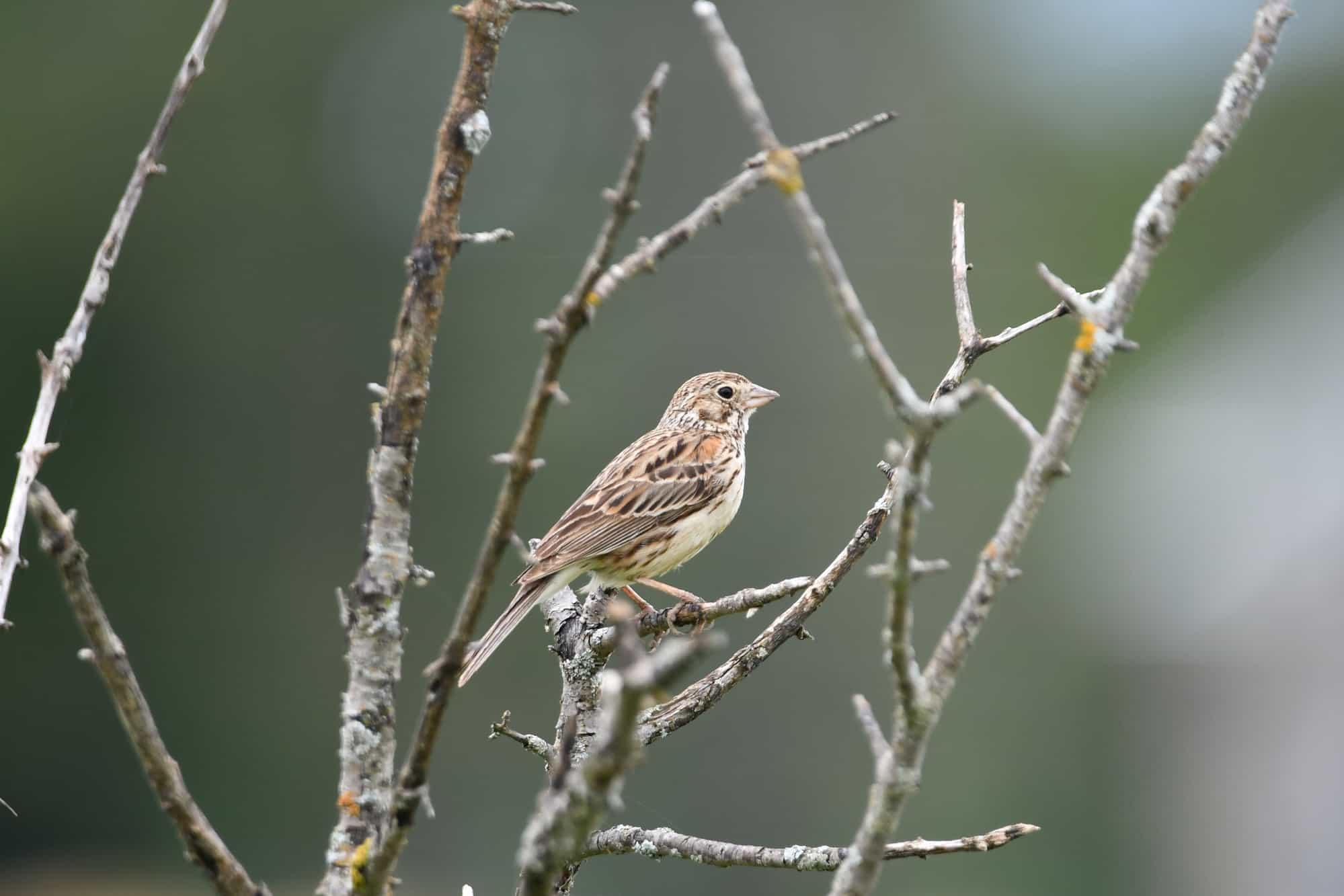
- Scientific Name: Pooecetes gramineus
- Length: 5.1-6.3 in (13-16 cm)
- Weight: 0.7-1.0 oz (20-28 g)
- Wingspan: 9.4 in (24 cm)
Vesper sparrows are closely related to lark sparrows, which are even rarer than they are in Georgia. One of the ways you can tell them apart from their cousin is the flash of white feathers that are seen during flight.
These medium-large sparrows are only present in Georgia during the winter months when they take refuge from their more northerly breeding grounds. They are never a common sight, however, and their numbers have been declining across North America.
Modern agricultural practices are thought to be partly to blame for its demise since this sparrow requires grasslands with high biodiversity to thrive. Conservation efforts will be critical to prevent populations from declining even further.
White-crowned Sparrow
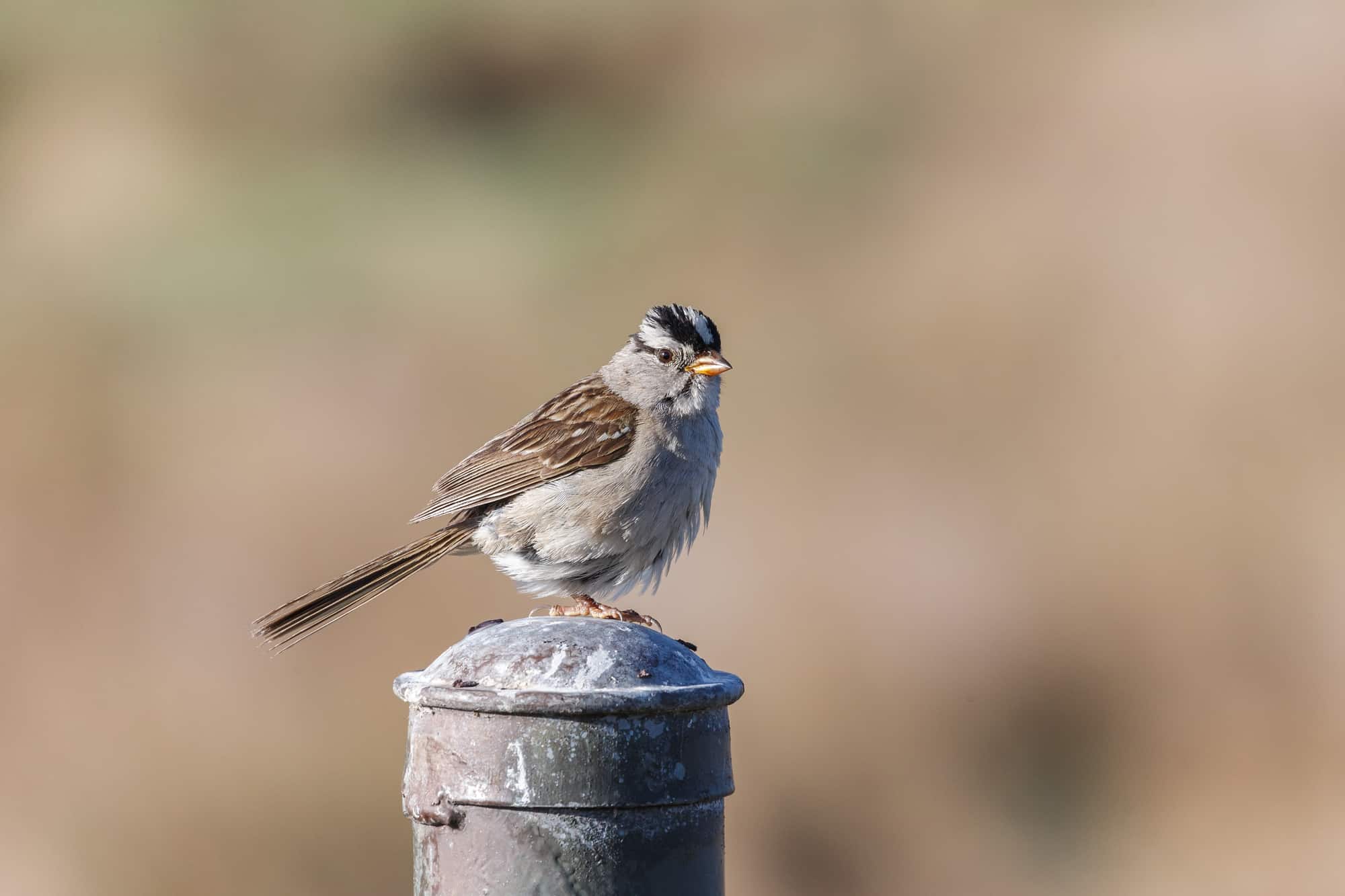
- Scientific Name: Zonotrichia leucophrys
- Length: 5.9-6.3 in (15-16 cm)
- Weight: 0.9-1.0 oz (25-28 g)
- Wingspan: 8.3-9.4 in (21-24 cm)
The white-crowned sparrow is one of the largest members of the Zonotrichia tribe of sparrows. They’re fairly easy to recognize by their black-and-white striped head, and orange-pink bill.
Georgia is purely a wintering ground for these birds which spend the summer in the far north of Canada, Alaska, and the Rocky Mountains. Although they are common in other states, they are relatively rare in Georgia.
You can find white-crowned sparrows moving around in large flocks over weedy and brushy areas and you can also attract them to your backyard by offering them sunflower seeds, millet, and other types of bird food.
Bachman’s Sparrow
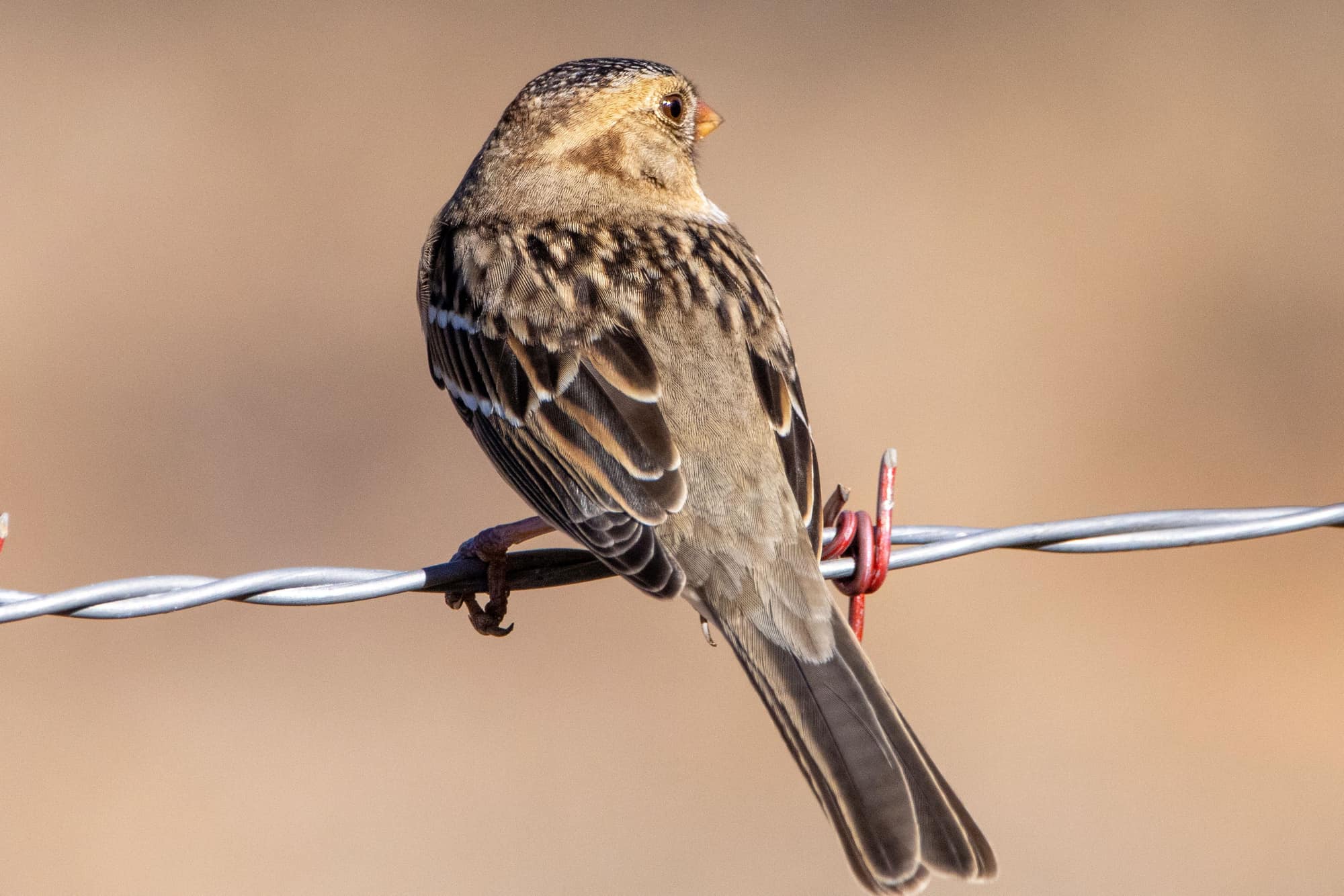
- Scientific Name: Peucaea aestivalis
- Length: 12.4 -15.2 cm (4.9 – 6 in)
- Weight: 18 – 22 g (0.6 -0.8 oz)
- Wingspan: 18.4 cm (7.2 in)
Bachman’s sparrow is also known as the ‘pinewood’s sparrow’ or ‘oakwoods sparrow’. Although not easy to distinguish by sight, you can identify this tiny sparrow by its song – a clear whistle followed by a short, sharp trill.
The Bachman’s sparrow has a narrow geographical range and is exclusive to southeastern states between North Carolina to Texas. It can be found in Southern Georgia throughout the year, but in the north only during summer.
These warmth-loving birds build domed nests, usually near the ground, and will sometimes use a gopher’s burrow to hide in! They are considered to be near threatened by the IUCN, with habitat loss thought to be a major cause of their decline.
Seaside Sparrow
- Scientific Name: Ammospiza maritimus
- Length: 5.1-5.9 in (13-15 cm)
- Weight: 0.7-1.0 oz (19-29 g)
- Wingspan: 7.1-7.9 in (18-20 cm)
The seaside sparrow is a small sparrow species that spends most of its time in coastal marshes. It’s more of a gray color than most sparrows, and it also has a particularly long bill that they use for digging up tasty snacks from deep in the mud!
You can see seaside sparrows along much of the east coast, and Georgia is no exception. They are found here throughout the year in coastal areas, but you might require a good pair of binoculars to spot and identify them accurately!
In the spring they build their nests out of grass among tall, marshy vegetation.
Saltmarsh Sparrow
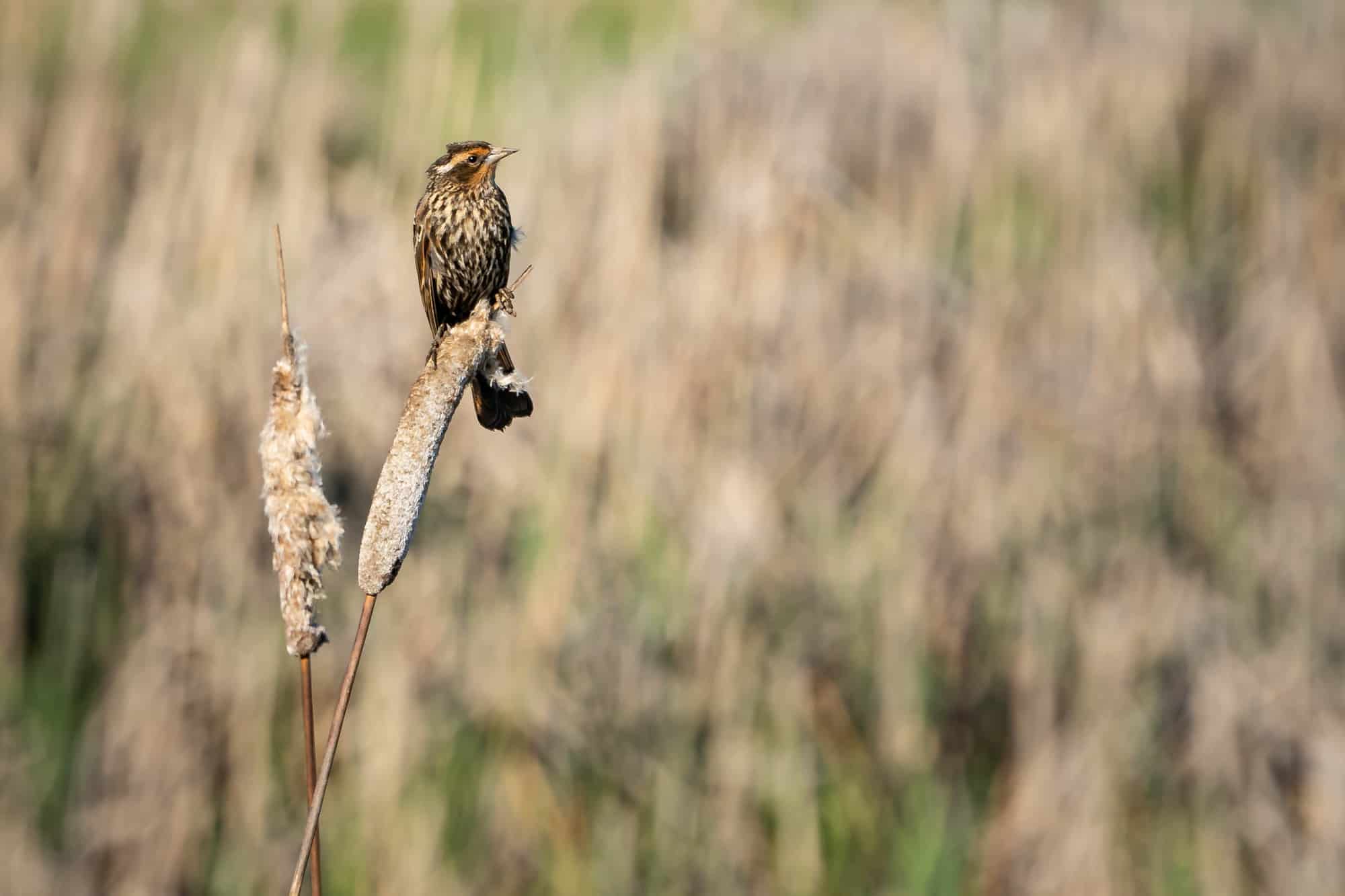
- Scientific Name: Ammospiza caudacuta
- Length: 4.7-5.1 in (12-13 cm)
- Weight: 0.6-0.8 oz (17.1-24.1 g)
- Wingspan: 6.5-7.7 in (16.5-19.5 cm)
Like their cousin, the seaside sparrow, the saltmarsh sparrow is a small bird that can be found along the east coast of North America. They can be told apart from their relatives by the orange feathers on their faces.
To spot them, you’ll need to go out looking at mud flats during low tide when these birds will scour the mud, looking for insects and other creatures that have been exposed by the receding tidal water.
Georgia is only a winter habitat for this migratory sparrow. For the spring and summer, they fly to the coastal areas of the Northeastern United States.
Nelson’s Sparrow
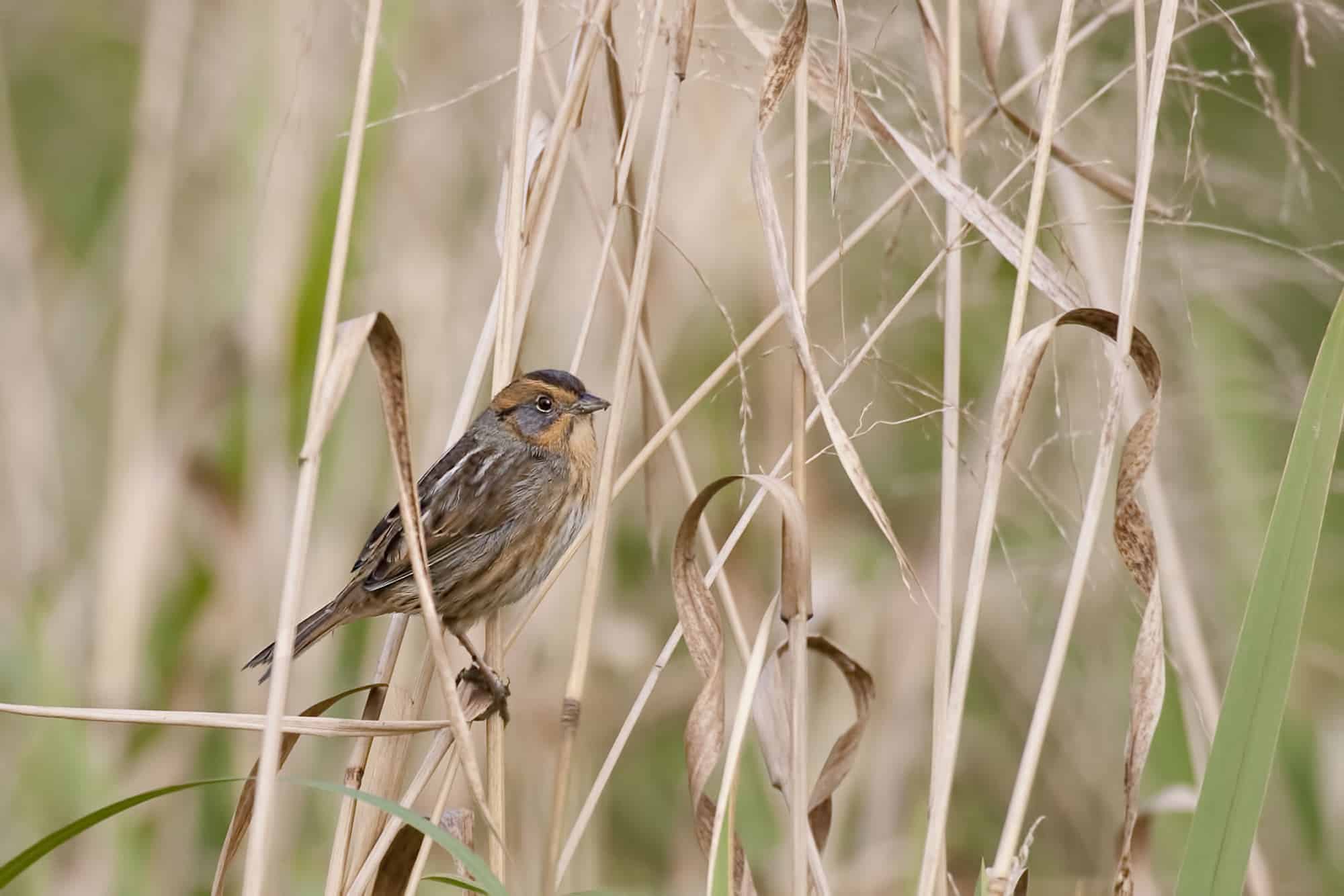
- Scientific Name: Ammospiza nelsoni
- Length: 4.3-5.1 in (11-13 cm)
- Weight: 0.6-0.7 oz (17-21 g)
- Wingspan: 6.5-7.9 in (16.5-20 cm)
Nelson’s sparrows are very similar to saltmarsh sparrows and were thought to be the same species until 1989! Now known to be distinct, the distribution map for Nelson’s sparrows had to be redrawn. It turns out they have confined local residencies, but a large migratory range.
Like their cousins, the saltmarsh sparrow, they rely mainly on insect species and mollusks as their chief source of food. Protecting the remaining marshlands may prove critical to their long-term survival.
One of the places that this mysterious species overwinters is the coastline of Georgia. Their preferred habitat is salt marshes but they can be found in other types of wetlands, too. They often sing at night with a curious, hiss-like call.
Lincoln’s Sparrow
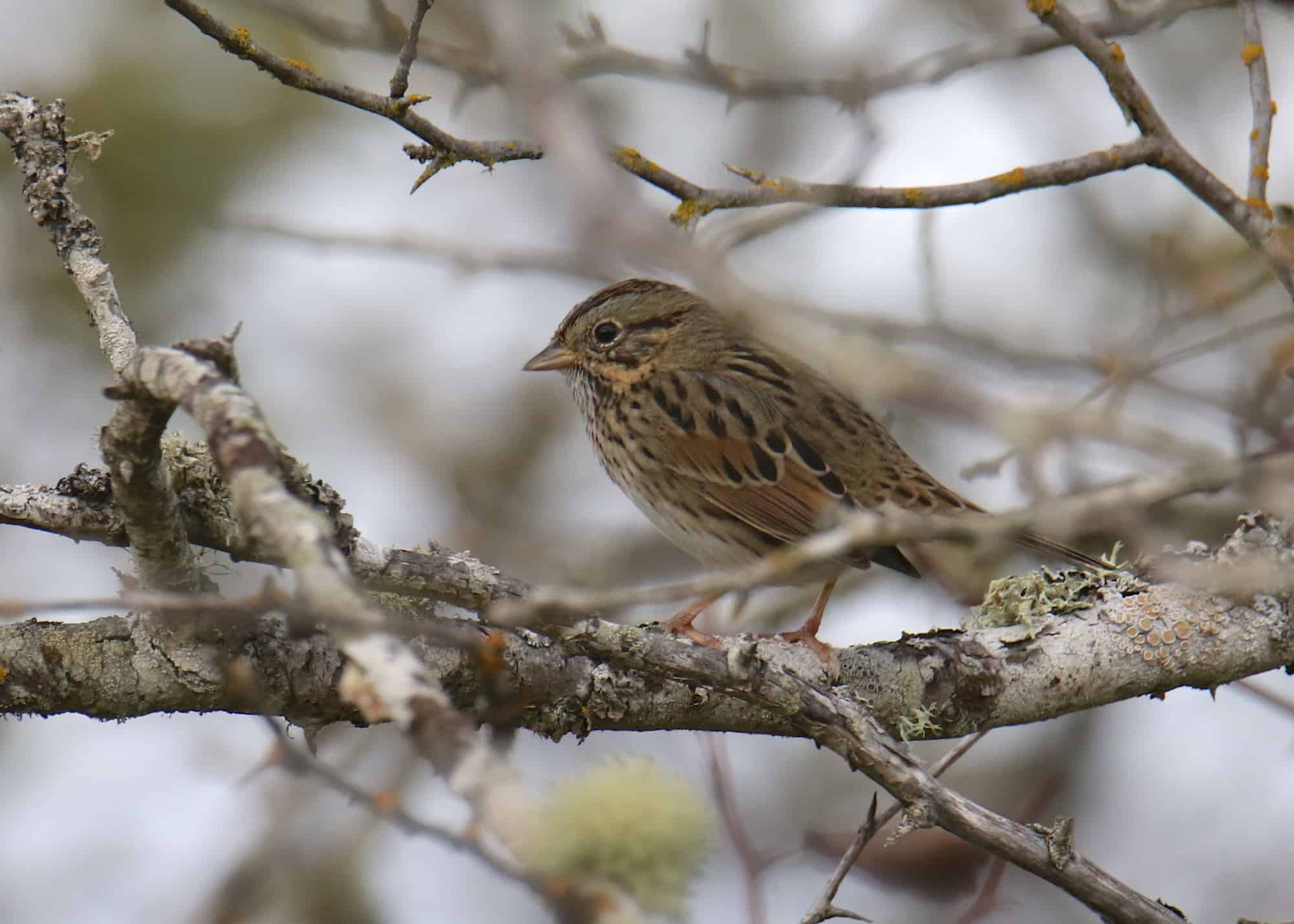
- Scientific Name: Melospiza lincolnii
- Length: 5.1-5.9 in (13-15 cm)
- Weight: 0.6-0.7 oz (17-19 g)
- Wingspan: 7.5-8.7 in (19-22 cm)
The Lincoln’s sparrow might be fairly difficult to recognize by sight but is easily identified by their song, which is one of the sweetest of any sparrow species in North America. Listen out for it in Georgia in early spring, as they prepare for their flight to their northerly nesting grounds.
The mild climate of Georgia’s winters offers this medium-sized sparrow a refuge during the colder months before they return to more northerly and mountainous areas for breeding. They are never a common bird here but can be seen more regularly during the spring and fall migrations.
Lincoln’s sparrow has a long way to fly every season between its winter grounds in the Southern United States and Central America, to its breeding grounds in the Northern United States and Canada.
Henslow’s Sparrow
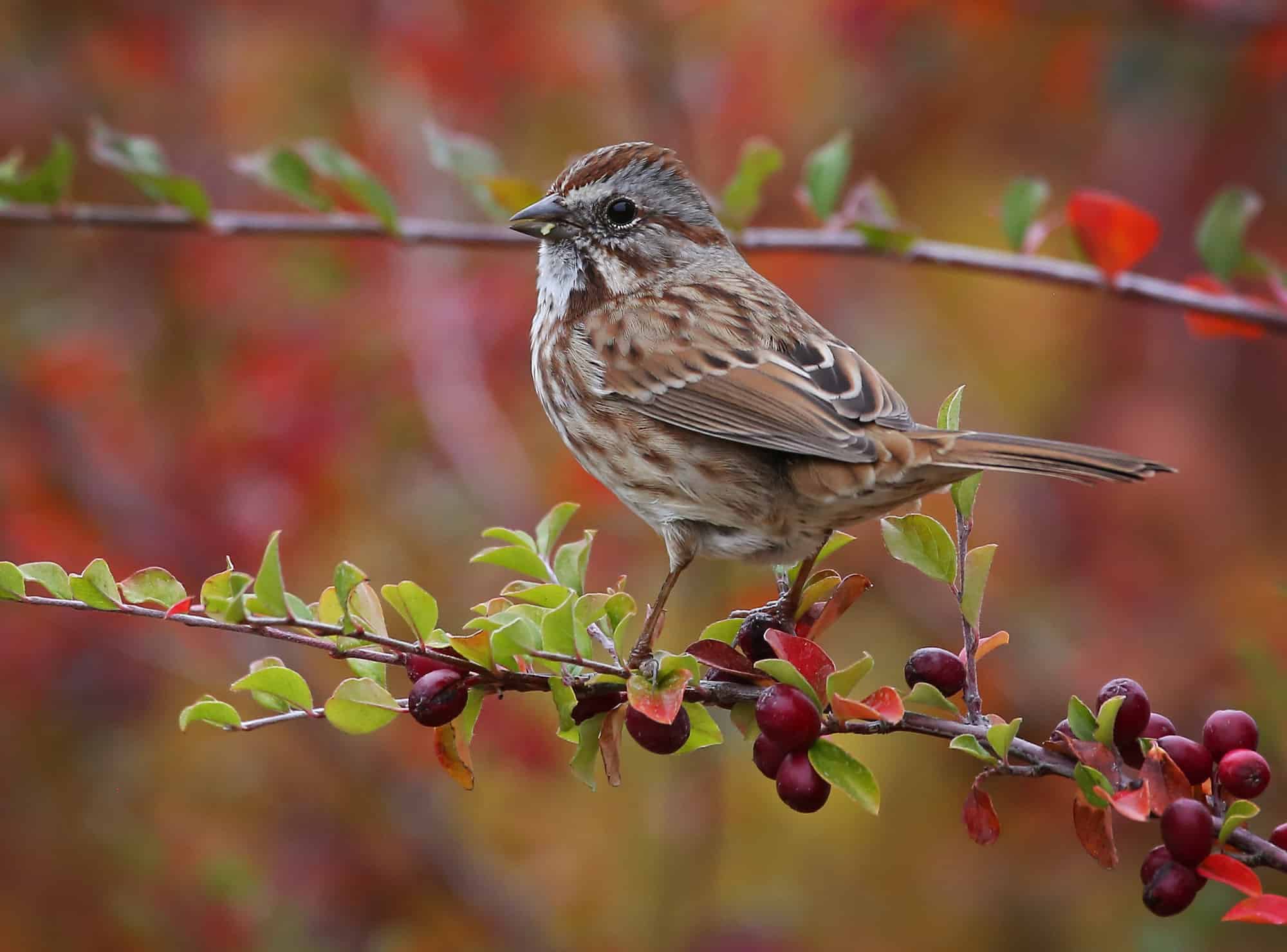
- Scientific Name: Centronyx henslowii
- Length: 4.75 – 5.25 in (12 – 13 cm)
- Weight: 0.5 oz – (14 g)
- Wingspan: 6-7 in – (15 – 18 cm)
A tiny sparrow with a short tail and a large head, Henslow’s sparrow is one of the smallest sparrows in North America. They can be recognized by their orangey upper body and yellow head and neck.
A rather rare and regional sparrow, this species overwinters in a narrow band of territory that includes only the southern half of Georgia.
Since Henslow’s sparrow is so small, shy, and well-camouflaged, it should be considered prized spotting. Even their song is quiet and subtle, sounding more like an insect or mouse than a bird!
Lark Sparrow
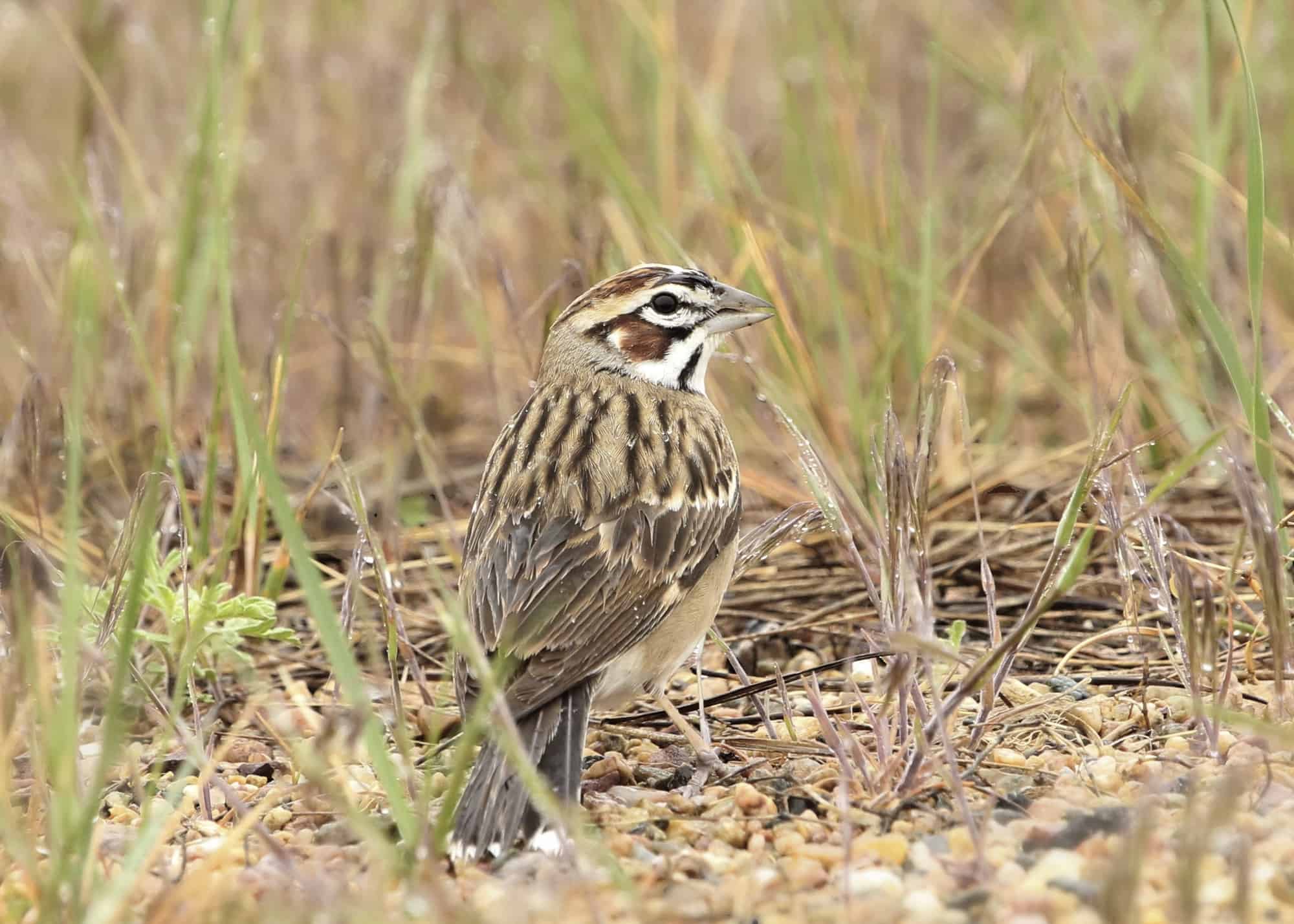
- Scientific Name: Chondestes grammacus
- Length: 5.9-6.7 in (15-17 cm)
- Weight: 0.8-1.2 oz (24-33 g)
- Wingspan: 11.0 in (28 cm)
Not to be confused with their striking cousin the lark bunting, lark sparrows are most easily recognized by their large size, bright white underside with a dark spot on their chest, and white tips on their tail. Closer inspection also reveals distinct black stripes on their face and a tan crown.
Although much more common further west, lark sparrows are a rare sighting this far east, and you’re most likely to see them here during the breeding season in the northwestern parts of Georgia. Their favorite habitats are open grasslands and meadows.
Clay-colored Sparrow
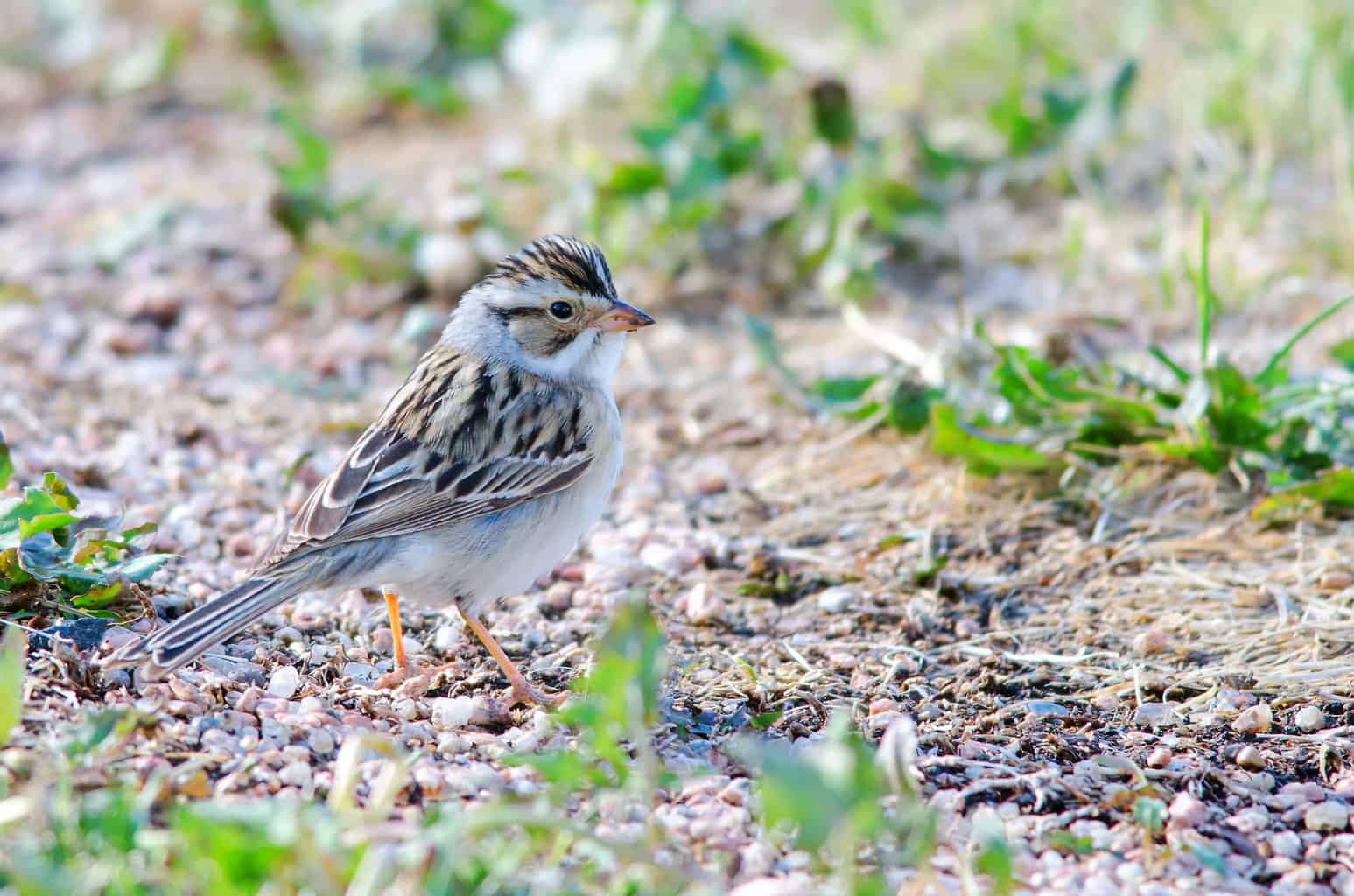
- Scientific Name: Spizella pallida
- Length: 5.1 – 6 in (13 – 15 cm)
- Weight: 0.42 oz (12 g)
- Wingspan: 7.5 in (19 cm)
The clay-colored sparrow is a cousin of the chipping sparrow, and also similar looking to Brewer’s sparrow. This species is aptly named after its singular pale brown chest during the winter months. Between April-August, however, its chest turns more of a white color.
The typical wintering grounds of the clay-colored sparrow are in Central America, but the warming climate could see this range extending north. These birds are a very rare sight in Georgia but have been spotted more frequently in recent years.
LeConte’s Sparrow
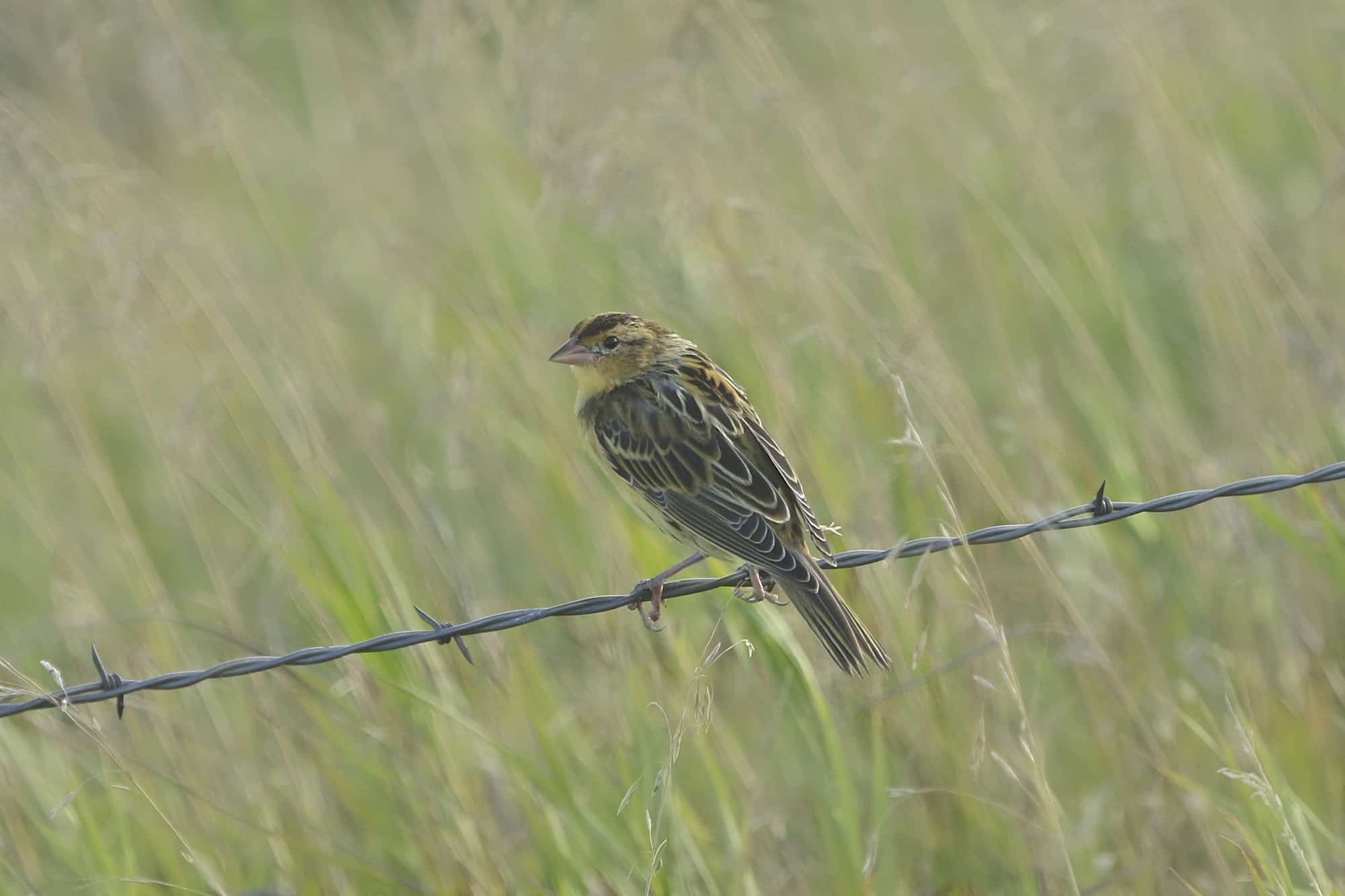
- Scientific Name: Ammospiza leconteii
- Length: 4.7-5.1 in (12-13 cm)
- Weight: 0.4-0.6 oz (12-16.3 g)
- Wingspan: 6.3-7.1 in (16-18 cm)
A close cousin of the grasshopper sparrow, and Henslow’s sparrow, LeConte’s sparrow is another tiny bird of wild, grassy habitats. It can be told apart from its relatives by the crisp, dark streaks on its flanks and its smaller bill.
This species also prefers to inhabit damper grasslands than grasshopper sparrows, but dryer than its other relatives Nelson’s sparrow and the saltmarsh sparrow. Its secretive nature makes it difficult to spot except when it’s singing – a song that sounds more like an insect than a bird!
LeConte’s sparrow overwinters exclusively in the Southeast of the USA but remains rarely spotted in Georgia. Perhaps its shy, reclusive nature contributes to the scarcity of sightings!
Conclusion
There’s a vast array of sparrows that can be spotted in Georgia, in every type of habitat imaginable!
Whether you’re enjoying watching house sparrows nibbling at sunflower seeds at your backyard feeder, or searching for a glimpse of the rare LeConte’s sparrow among damp grassland, there are endless opportunities to encounter these ‘little brown jobs’ in the Peach State.
Don’t forget, though, that sparrow species only make up a tiny part of the 425 birds that live in Georgia. To find out more about the rest of them, don’t miss our dedicated guide to 25 of the most amazing birds in Georgia!

